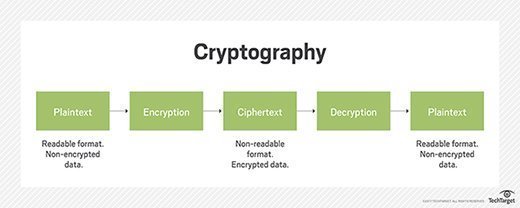What is an initialization vector?
An initialization vector (IV) is an arbitrary number that can be used with a secret key for data encryption to foil cyberattacks. This number, also called a nonce (number used once), is employed only one time in any session to prevent unauthorized decryption of the message by a suspicious or malicious actor.
What is an initialization vector in cryptography?
Many symmetric key encryption algorithms use a fixed-size random (or pseudorandom) IV as the initial input parameter. The IV's main purpose is to ensure that the first encrypted data block is random. It also prevents identical plaintexts from encrypting to an identical ciphertext by using a process called chaining, in which the previous encrypted block is seeded into the next block to be encrypted in order to remove discernible patterns in the resulting ciphertext.
By ensuring that plaintexts, even those that are identical or have some commonalities (e.g., a header), encrypt differently, an IV destroys patterns in the resulting ciphertext. In other words, it introduces cryptographic variance into the encryption process, which helps to increase data security.
Many encryption algorithms use only one IV to initialize the first encrypted block of data. Others, like Triple DES (3DES) used three IVs to provide stronger encryption than older DES algorithms. That said, using more IVs doesn't necessarily mean that the algorithm is inherently secure, if it has other weaknesses. For example, 3DES supports a maximum key size of only 192 bits, which can make applications susceptible to brute-force attacks. Also, the algorithm's triple encryption process makes it slower than some other algorithms.

Importance of an initialization vector
The use of an IV prevents the repetition of a sequence text in data encryption. Specifically, if an attacker can view the same encrypted data multiple times, they get clues to decrypt and interpret the original values. That's why encrypted ciphertext data is vulnerable to theft or compromise. An IV is meant to prevent this from happening.
A random number generator (RNG) generates a random, unique and unpredictable nonce that prevents patterns from emerging in the ciphertext. With a nonce IV, a sequence of plaintext that's identical to a previous plaintext sequence will not produce the same ciphertext. This stops hackers from viewing the same encrypted information multiple times, making it more difficult for them to decrypt the message via, for example, a dictionary attack.

How to generate an initialization vector
A random number generator is usually used to generate an IV for a cryptographic algorithm. The RNG ensures that the IV is random (or at least pseudorandom) and unpredictable to minimize the possibility of an unauthorized or malicious user inferring relationships between similar segments of an encrypted message.
Strong RNGs generate a new, unique IV for each encryption operation. This prevents patterns from emerging and being detected by threat actors, thus maintaining data security. The IV length can vary, depending on the encryption algorithm and the cipher's block size.
Properties of an ideal initialization vector
In a cryptographic algorithm, an IV is used as a starting state. Adding the IV to the cipher hides patterns in the encrypted data that might allow a hacker to decrypt it by guesswork or trial and error.
The ideal IV is a random or pseudorandom number. It must also be nonrepeating. Both randomness and nonrepetitiveness are crucial to prevent attackers from finding patterns in similar parts of the encrypted message and then using this information to decrypt the message.
The IV need not be secret. In fact, the destination computer usually knows the IV so it can decrypt the encrypted data when it receives it. Thus, the IV would be agreed on in advance by both the sender and the recipient. In addition, the IV can be transmitted independently or included as part of the session setup prior to message exchange.
The IV length in terms of the number of bits or bytes depends on the encryption method. In most cases, the length is comparable to the length of the encryption key or block of the cipher being used.
In general, an ideal IV that boosts the security of the encryption algorithm is random, unpredictable, unique and not reused.
Initialization vector vs. salt
In cryptography, salt refers to random data that's generated for passwords to protect passwords from precomputation attacks. A new, different salt is used for each password instance and added to the front of the password. This makes it hard for hackers to build a table or dictionary of common passwords and thus safeguards the password from attacks that rely on such tables. One example is rainbow table attacks.
An IV is a specific type of a nonce. In general, a nonce is a bit of data that's used only once with a cryptographic key in a cryptographic algorithm. A random number generator or pseudorandom number generator is used to generate nonces for various algorithms. IVs are random, unpredictable chosen nonces that are used only once to ensure that a communication session is unique and, therefore, less susceptible to replay and other types of cyberattacks.
Ways to make the IV available to a recipient
For a recipient to decrypt the encrypted message, they must know the IV. There are many ways to make the IV available to the recipient to facilitate decryption. One way is to transmit it along with the ciphertext. Another way is for both the sender and recipient to agree on the IV during the key handshake or exchange.
The recipient can also discover the IV by calculating it incrementally or by measuring parameters like current time, using the sender's or recipient's address, or by using the packet or cluster number.
Use of IVs in block ciphers and stream ciphers
Both stream and block ciphers use a symmetric key and algorithm for data encryption. IVs are implemented differently in both types of ciphers. A block cipher is a way to encrypt data in blocks simultaneously to produce ciphertext. In contrast, a stream cipher encrypts and decrypts data one bit at a time.
In the Electronic Code Book (ECB) mode, which is a simple mode of operation with block ciphers, the same plaintext is always encrypted with the key into identical ciphertext. In other words, encryption of the same plaintext with the same key generates the same ciphertext, leaving the message vulnerable to compromise. Adding an IV to the plaintext's first block (XOR) addresses this problem and increases data security and integrity.
In the cipher-block chaining (CBC) mode, the IV has an unpredictable value and is added to the first plaintext block. In subsequent encryption steps, the ciphertext produced in the previous step is added to the next plaintext block. The process continues until the entire message is encrypted with a high degree of cryptographic variance.
In stream ciphers, an IV is added to the keyed internal secret state. After this, multiple cipher rounds are executed before the first bit of output is released. Despite the presence of the IV, stream ciphers are not entirely secure. One reason is that the same key is used to both encrypt and decrypt the plaintext data. Security can also be compromised if the keystream bits are not sufficiently random or unpredictable, or if the keys are reused.
Initialization vector in WEP IV
The Wired Equivalent Privacy or WEP algorithm is part of the 802.11 standard that describes communications in wireless LANs. WEP relies on a secret key that is shared between a mobile station and an access point and is used to encrypt data packets before they are transmitted.
WEP uses the RC4 encryption algorithm, which is a stream cipher. It performs an integrity check to ensure that packets are not modified in transit. For this, it uses a 24-bit IV. The IV is included in the packet in the cleartext part of a message. Its goal is to ensure that two ciphertexts are not encrypted with the same key stream. However, because the IV is short, the same key stream is often reused, which allows hackers to perform statistical attacks to recover the plaintext and decrypt traffic.
WEP is vulnerable to many kinds of attacks, including passive attacks to decrypt traffic, active attacks to inject malicious traffic and table-based attacks in which attackers can easily decrypt all packets using the same IV. Due to such weaknesses, the WEP is no longer a popular encryption algorithm.
Using an initialization vector in different modes
Block ciphers use different modes to mask the patterns within the ciphertext to prevent attackers from guessing it. Here's how an IV is used in various modes.
Cyber Block Chaining (CBC) Mode
CBC uses an IV to prevent having the same plaintext result in the same (guessable) ciphertext. It's important that the IV is random and unique. Otherwise, attackers might be able to guess the ciphertext and easily decrypt the data.
IV type: random and unpredictable.
Ciphertext feedback (CFB) mode
In CFB, the IV is used as a source of the stream generated by the cipher. As with CBC, the IV must be random to prevent predictability and maintain the data's confidentiality and integrity.
Moreover, the IV must not be reused because doing so can reveal information about the common blocks shared by two messages, thus allowing a hacker to decrypt a subsequent message.
IV type: random and unpredictable.
Counter and output feedback (OFB) modes

These modes make a block cipher into a synchronous stream cipher. The cipher is initialized with an IV. When 12 bytes are allocated to the IV and 4 bytes to the counter, it enables the encryption of a message of length 2^32 blocks. As with the other modes, reusing the IV will result in the reuse of the key bitstream, increasing the chances of unauthorized decryption by an eavesdropper.
IV type: unique (counter).
Galois/counter (GCM) mode
This mode protects both plaintext and additional authenticated data (AAD). But again, IV uniqueness determines authentication and data security. GCM uses the Advanced Encryption Standard (AES) encryption with an IV length of 16 bytes. The first 12 bytes are assigned to the IV and the remaining 4 bytes to the nonce counter.
IV type: unique IV (12 bytes) + unique counter (4 bytes).
Explore the differences between AES vs. DES encryption and symmetric vs. asymmetric encryption. See how to use a public key and private key in digital signatures and how to use centralized encryption methods in large-scale IT environments. Check out our comprehensive guide to data security. Learn how encryption is implemented in hardware through the use of hardware security modules.
